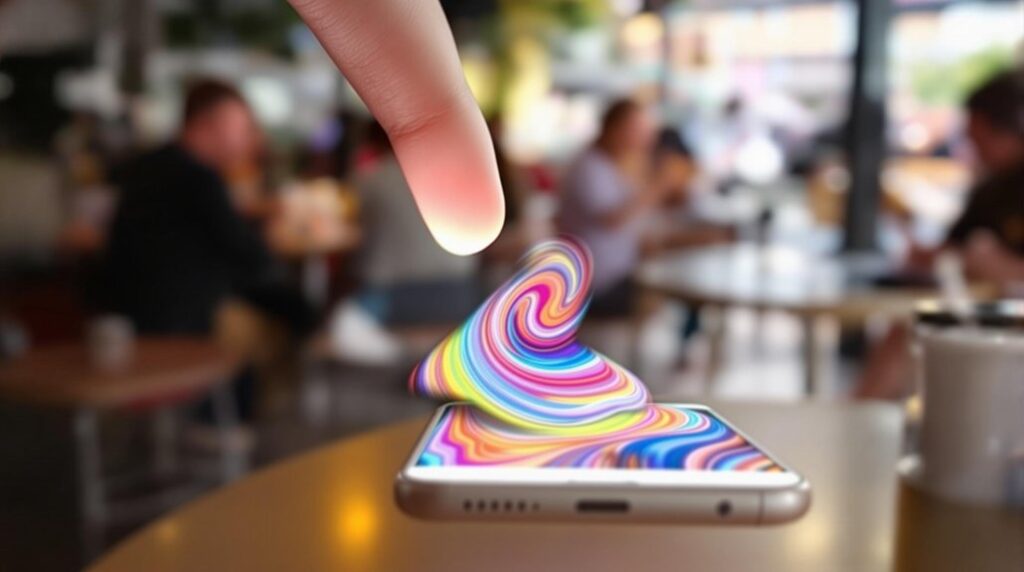On Snapchat, "uhm" functions as a linguistic pause, strategically used to indicate hesitation, cognitive processing, and foster casual conversation flow. It softens communication, enhancing dialogue by providing users time to gather thoughts, and can signal uncertainty or curiosity. This filler word plays a significant role in enhancing interpersonal connections, especially in informal settings among familiar acquaintances. The popularity of "uhm" is particularly observed in Snapchat's young user demographic—reflecting the platform's relaxed and engaging nature. Understanding its nuanced use can offer deeper insights into digital communication dynamics and interpersonal exchanges.
Key Takeaways
- "Uhm" on Snapchat is a linguistic pause reflecting hesitation or uncertainty in digital conversations.
- It serves as a filler word, allowing users time to contemplate responses and maintain dialogue flow.
- "Uhm" indicates active listening and engagement, enriching interpersonal connections on Snapchat.
- It creates a relaxed, informal atmosphere, making interactions more approachable and casual.
- The term reflects cognitive processing, signaling thoughtful engagement before formulating a response.
Definition of Uhm
In what ways does the term "uhm" function within Snapchat interactions? This common filler word, "uhm," plays a multifaceted role in digital communication, reflecting both psychological implications and cultural differences.
Psychologically, "uhm" signifies a pause, allowing users to momentarily collect their thoughts, thereby enhancing the clarity of their responses. It introduces a human element into the conversation, reflecting hesitation or uncertainty, and suggesting cognitive engagement. The presence of "uhm" can indicate that users are thoughtfully considering their responses, which can deepen conversational quality by conveying genuine reflection rather than a hurried reply.
Culturally, the use of "uhm" varies, reflecting differing communication styles across diverse backgrounds. In some cultures, the term may be perceived as a natural aspect of speaking, enhancing the casual and informal tone typical of Snapchat interactions among peers.
It can serve to bridge cultural communication gaps by signaling a relaxed conversational style, promoting a sense of camaraderie. The term's adaptability across cultures underscores its universal role in digital discourse.
Ultimately, "uhm" not only functions as a linguistic pause but also as a tool for enriching interpersonal connections on Snapchat, providing insight into the speaker's thought process and emotional state.
Usage Context on Snapchat
A closer examination of "uhm" within Snapchat reveals its strategic role in facilitating digital communication. This seemingly innocuous term functions as a pivotal element in the domain of social cues and texting etiquette. On Snapchat, "uhm" frequently acts as a filler word, signaling hesitation or uncertainty. It provides users a momentary pause to contemplate their responses, thereby enhancing the conversational flow. Such usage underscores the adaptability of digital language in replicating real-world interactions where pauses are natural and expected.
The presence of "uhm" in Snapchat chats and stories is indicative of its multifaceted role. It is often employed in casual exchanges to soften statements, reflecting a lack of confidence or indecision. This aligns with the principles of texting etiquette, where tone modulation is essential in conveying the intended message.
In addition, "uhm" contributes to a relaxed, informal atmosphere, making interactions more approachable and personal. The data suggests that "uhm" is not merely a verbal tic but a deliberate choice to manage the conversational dynamics on Snapchat. It aids in expressing contemplation, thereby enriching the digital dialogue by allowing for nuanced communication without the immediacy typically associated with text-based interactions.
Examples in Conversations
In examining conversational dynamics on Snapchat, the use of "uhm" frequently serves as a marker for common pauses, where users momentarily hesitate while formulating their thoughts.
This linguistic element often conveys uncertainty, as seen when individuals express tentative commitments or require additional information before proceeding.
Analyzing these interactions can provide insights into how digital communication accommodates informal, thought-processing exchanges, maintaining conversational flow despite the absence of face-to-face cues.
Common Conversational Pauses
Conversational pauses, such as the frequent use of "Uhm" on Snapchat, serve as essential communicative tools that provide insight into a speaker's cognitive process.
These pauses, often manifested as hesitation cues or conversational fillers, help users articulate their thoughts more effectively while maintaining the flow of dialogue. The employment of "Uhm" is a key indicator that the speaker is maneuvering through uncertainty or formulating a response, consequently offering a glimpse into their mental deliberations.
Utilizing "Uhm" serves multiple purposes in digital conversations on platforms like Snapchat:
- Hesitation Cues: Indicate when a user is taking a moment to think, highlighting their need for additional time to respond appropriately.
- Conversational Fillers: Bridge pauses, preventing abrupt silences that could disrupt the conversational flow.
- Reflective Thinking: Signal that the user is engaged in contemplation, thereby enhancing the interpretative richness of the exchange.
- Informal Tone: Foster a relaxed conversational atmosphere, suggesting that the dialogue is informal and personal.
Expressing Uncertainty in Chats
On Snapchat, the use of "uhm" frequently signals a user's uncertainty or hesitation in response to messages, serving as a linguistic marker of their cognitive engagement. This hesitation cue not only reflects the individual's thought process but also plays a strategic role in conversational dynamics. By using "uhm," users can pause, allowing themselves the necessary time to formulate more thoughtful responses. This is particularly evident in phrases like "Uhm, I'm not sure what you mean," which highlight a need for clarification and additional information.
Moreover, "uhm" functions as a conversational softener, helping to mitigate the abruptness or potential confrontation of statements. In the informal context of Snapchat chats, where tone can often be misinterpreted, such modifiers are essential. They allow users to navigate social interactions with greater nuance, ensuring that communication remains friendly and non-confrontational.
In group chat scenarios, the introduction of "uhm" can signal active consideration and engagement from the sender. This subtle cue fosters a collaborative atmosphere, encouraging other participants to contribute and share insights.
Consequently, "uhm" is a versatile tool in Snapchat's conversational arsenal, enhancing user interaction through its facilitation of thoughtful, respectful exchanges.
Importance in Communication
The integration of "uhm" in Snapchat conversations plays a critical role in enhancing the flow of dialogue by providing users with additional time to formulate their thoughts, thereby promoting more meaningful exchanges.
Data suggests that this linguistic pause not only indicates thoughtful engagement but also allows for a more patient and considerate communication style, reducing the impulse for hasty responses.
Enhancing Conversational Flow
Although often overlooked, the incorporation of filler words like "uhm" in Snapchat conversations plays a crucial role in enhancing conversational flow. Within the domain of conversational dynamics, "uhm" acts as a key social cue, facilitating smoother exchanges by serving as a pause for thought. This filler word allows users to signal that they are processing information, ensuring that conversations remain natural and unhurried.
By indicating that one is actively considering their response, "uhm" promotes a relaxed atmosphere, encouraging meaningful interactions.
From a data-driven perspective, the benefits of using "uhm" in Snapchat dialogues can be categorized as follows:
- Indicates thoughtfulness: Users are not rushing their responses, demonstrating engagement.
- Serves as a conversational bridge: Helps shift between topics without abruptness.
- Softens communication: Creates a gentler interaction, reducing conversational pressure.
- Fosters engagement: Signals active participation, enhancing the dialogue's quality.
These aspects underscore the importance of "uhm" in maintaining a balanced conversational flow. By recognizing its function as more than a mere pause, users can leverage "uhm" to improve the quality of their Snapchat interactions.
This nuanced understanding of filler words like "uhm" ultimately contributes to more effective and engaging communication.
Indicating Thoughtful Engagement
Building on the role of filler words in enhancing conversational flow, "uhm" on Snapchat serves as a pivotal cue for indicating thoughtful engagement. In digital interactions, where non-verbal cues are absent, the inclusion of "uhm" provides an essential conversational cue, suggesting that the speaker is engaging in thoughtful pauses to process information before responding. This filler word conveys a level of uncertainty or hesitation, allowing users to communicate that they are actively considering their reply rather than impulsively responding.
The thoughtful pauses signaled by "uhm" contribute to a relaxed and informal atmosphere within Snapchat conversations. This dynamic fosters an environment where users feel encouraged to engage deeply with the dialogue, indicating active listening and demonstrating a commitment to the interaction. Data indicates that the presence of "uhm" in exchanges can reduce the pressure to reply immediately, supporting smoother and more meaningful interactions.
Furthermore, recognizing and employing "uhm" strategically in Snapchat dialogues highlights the user's engagement and reflective consideration, thereby valuing the ongoing conversation. This nuanced use of conversational cues ultimately enhances the quality of communication, promoting an exchange that is both thoughtful and considerate, and sustaining the conversational flow.
Allowing Response Time
In digital communication, particularly on platforms like Snapchat, the use of "uhm" plays a crucial role in allowing response time, thereby enhancing conversational quality. This verbal pause functions as an effective response strategy, enabling users to maintain the fluidity of conversational dynamics. It signals to the other party that the speaker is actively engaged and processing information, which is essential in a fast-paced digital environment.
Analyzing the role of "uhm" reveals several key functions:
- Thought Gathering: It provides a moment for individuals to organize their thoughts, contributing to more coherent and meaningful responses.
- Pressure Reduction: By using "uhm," speakers can alleviate the immediate pressure to reply, allowing them to reflect on their responses more thoroughly.
- Engagement Indicator: This filler word demonstrates active listening and engagement, suggesting the speaker values the interaction.
- Conveying Uncertainty: "Uhm" can express contemplation and uncertainty, offering a non-disruptive way to reflect on the conversation.
Incorporating "uhm" as a response strategy in conversational dynamics on Snapchat and similar platforms reflects a natural, widely accepted aspect of communication. It enriches dialogue by promoting thoughtful exchanges, ultimately leading to enriched interpersonal connections in digital interactions.
Variations and Similar Terms
The use of filler words like "uhm" in digital communication, particularly on platforms like Snapchat, highlights a broader linguistic trend where individuals employ these terms to convey hesitancy or contemplation. Variants such as "um," "erm," and "hm" serve similar functions.
These filler word variations are fundamental to texting culture, reflecting the informal nature of digital dialogues. They allow individuals to express uncertainty or to pause and gather their thoughts without interrupting the conversational flow.
The impact of texting culture on language is evident as terms like "uh," "like," and "you know" emerge as similar fillers, softening statements or providing additional time for response formulation. Despite the interchangeability of these terms, each carries subtle nuances that can indicate different levels of uncertainty or thoughtfulness.
Understanding these variations is significant as it enhances the interpretation of a speaker's intent and emotional undertones in digital interactions.
The widespread adoption of "uhm" and its synonyms on Snapchat underscores their role in facilitating casual exchanges. As users navigate informal communication, these filler words become essential tools to articulate their thought processes and manage conversational dynamics effectively.
Popularity and Trends
Snapchat's youthful user base primarily embraces the term "uhm," marking a significant trend in digital communication that aligns with their preference for casual and informal interactions. This linguistic tendency underscores the platform's role in shaping modern texting culture, where brevity and relatability are paramount.
Recent analyses reveal that "uhm" is not merely a filler but an integral part of digital expression, often paired with memes to enhance their humorous or relatable impact. The integration of "uhm" in memes further cements its status as a cultural touchstone among young users.
- The term "uhm" frequently appears in memes, adding a layer of relatability.
- Snapchat's data indicates high engagement rates for content featuring "uhm."
- "Uhm emojis" are increasingly used alongside text, enriching conversational nuance.
- Videos exploring "uhm" accrue significant viewership, highlighting its relevance.
Furthermore, "uhm" serves as a linguistic tool that signifies hesitation or contemplation, reflecting the dynamic nature of Snapchat interactions. The term's popularity is evident as it seamlessly integrates into the larger framework of social media language, influencing communication norms.
As Snapchat continues to dominate youth social media engagement, the usage of "uhm" illustrates broader trends in informal digital dialogue.
Uhm in Women's Texting
Maneuvering the nuances of women's texting, the term "uhm" emerges as a multifaceted linguistic device that signifies more than just a pause. In the context of women's communication, "uhm" serves as a strategic tool, delineating a space for cognitive processing. Data indicates that when women employ "uhm," it often signifies a momentary pause to formulate a coherent response. This textual pause is not merely a filler but a deliberate choice, reflecting a nuanced hesitation to articulate feelings or opinions, especially when uncertainty looms over the conversational terrain.
Analyzing texting nuances further reveals that "uhm" can function as an indicator of topic avoidance, with the texter carefully contemplating their next move. Such usage underscores the complexity of digital dialogue management, where "uhm" signals engagement while allowing for introspective thought.
Additionally, this linguistic marker can express disbelief or doubt, subtly questioning the validity of statements within the conversation. This implies that "uhm" is not merely passive but actively shapes the interaction landscape. Consequently, in women's texting, "uhm" transcends its surface function, evolving into a sophisticated communicative tool that balances engagement with deliberation.
Uhm in Men's Texting
Examining the role of "uhm" in men's texting reveals distinct communicative strategies compared to its usage in women's texting. The uhm meaning in this situation often suggests a strategic pause, allowing men to formulate a clever or thoughtful response to a question or statement. This behavior highlights an intention to be considerate and deliberate in their communication.
Additionally, "uhm" can indicate active listening, which shows engagement and attentiveness in the conversation as they carefully consider their reply.
The uhm interpretation in men's texting can also reflect a tactic to buy time. This approach is particularly useful in discussions that require reflection, allowing the sender to gather their thoughts before responding.
Moreover, "uhm" may serve as an expression of curiosity or interest in the topic, signaling contemplation of the implications within the conversation. This usage is generally observed in informal settings with friends or close acquaintances, reflecting a casual conversational style.
Key insights into men's texting with "uhm" include:
- Reflective pause for crafting responses
- Indication of active listening and engagement
- Time-buying strategy for thoughtful replies
- Expression of curiosity and interest in the conversation
Frequently Asked Questions
Does UHM Mean Yes or No?
The interpretation of "uhm" is context-dependent, signifying hesitation or uncertainty rather than a definitive "yes" or "no." Its presence in conversations may indicate a non-committal stance, reflecting the speaker's contemplation or indecisiveness.
What Does Uhmmm Mean in Texting?
In texting etiquette, "uhmmm" serves as a conversation cue indicating prolonged hesitation or contemplation. This filler word allows users to maintain dialogue fluidity while reflecting on responses, often suggesting uncertainty or doubt in informal, casual communication settings.
What Does IMU Mean on Snapchat?
"IMU" in Snapchat slang is a texting abbreviation for "I Miss You," reflecting affectionate communication. This informal acronym enhances emotional engagement in digital interactions, particularly among younger users, by facilitating concise expression of sentiment across distances.
What Does HM Mean on Snapchat From a Girl?
In Snapchat exchanges, when a girl uses "HM," it signifies contemplation or uncertainty. This texting nuance reveals her engagement in the conversation while she deliberates her response, highlighting the subtleties of digital communication dynamics.
Conclusion
The term "uhm" on Snapchat serves as a conversational filler, often indicating hesitation, uncertainty, or a pause in thought. Its usage transcends gender, though contextual differences are observed in men's and women's texting patterns. The prevalence of "uhm" underscores its communicative importance in conveying nuanced emotional states or prompting further dialogue. Variations like "um" or "uh" follow similar trends. Analyzing these patterns reveals broader insights into digital communication behaviors and evolving linguistic norms in social media interactions.




